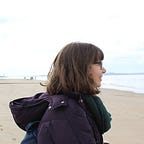#397: The Raku Pot
Crafting and the climate crisis
I have written many times about how much I love making things, and I have continually advocated for how rewarding, warming and occupying it is to see an object come to life in your own hands. But I have started thinking more deeply about crafts.
We’ll start first, however, with this raku pot. It is a beautifully imperfect object that I had the delight of making at the Make & Mend Festival. I say making, but all I really did was apply the glaze and let the experts do the rest. Now the pot sits on my desk, a solid item holding my pens. It is not just the culmination of a day out, of the act of letting go of my need for perfection, of sliding glaze across a pot and abandoning my expectations of how it might come out: this pot is also a keeper, because this pot has a use.
And it is here that my thoughts become thorny. Craft-making is wonderful, but if one thing has hit home whilst writing a blog about objects, it is their unnecessary proliferation and what that means in the context of the climate crisis.
Crafts do not instinctively feel environmentally or socially “evil”. Making something yourself, instead of mass-producing an item in a far away factory, definitely feels like a really good thing; there is no doubting that it can be. And if you are reusing pre-existing objects — if your craft is about fixing something — then you are minimising your environmental impact.
Is this realistically the full extent of the crafts I take part in though? Or do I have a large collection of craft items that were mass-produced and wrapped in plastic for the sole purpose of selling them to me, a consumer? Answer: yes. And is the thing I make often an object that, realistically, I will keep? Answer: no. How long, for example, do I want a model of a dinosaur on my bookshelf?
Even asking these questions, I feel cruel. Crafting brings people joy. My crafting pursuits increased hugely during the pandemic, keeping myself and many others alike entertained throughout several lockdowns. If the true environmental bad guys are actually a small number of very powerful people, why should I stop doing something that brings joy to my life? My unease feels… well, just a bit pernickety.
It is, however, about living in a way that fits with your understanding of the world. When I look at all the unusable objects I have created, I am filled with unease at their environmental impact, and some of the joy in making them is removed. These objects sit uncomfortably alongside the part of me that knows what is happening to our planet. Even if the real terms effect of crafting, or whatever activity you might yourself begin to examine, is minimal, if it doesn’t align with your views, perhaps that is enough to cause you to change. This is an argument I have heard video essayist Leena Norms make, when speaking about whether individual actions are worth it. It is an approach that resonates with me.
Even whilst living my values, I do not need to axe crafts completely from my life. That would be daft. Partly, because I have loads of unused craft items lying about, and partly because crafts make me happy. It is instead about being self-aware of your actions and learning as much as possible about their impact.
I am not, yet, an expert in the most environmentally friendly crafts. I can hazard a guess, though, and I can take this approach forward. First, if you are using items that already exist, that are already in your cupboard, then much of the impact has already been made. Second, if you are making useful items that you might otherwise buy — again, not a bad approach. I think here about my sturdy, useful pot or Katie’s knitting. Third, think about the process — making a pot requires energy for the intense heat of the kiln, but when drawing you are just using your hands. These are the pillars I will begin to use when I next decide to make something.
This is all part of a learning journey — a gradual re-learning of my relationship with objects. It will never be complete, but each little re-evaluation feels like a necessary step towards a more intentional life.
